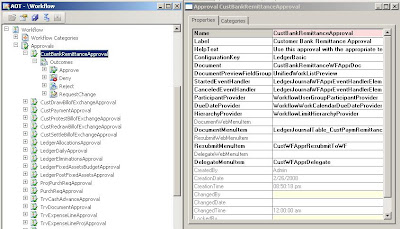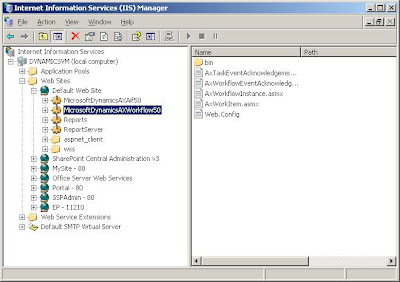Setup (Steps):-
-Setup AD User for Workflow Account & configure in AX
-Setup & Configure IIS on Web Server
-Setup Workflow Component using AX installation option
-Run the Workflow Infrastructure Configuration Wizard {Batch Jobs, Workflow site}
-Configure the Workflow in AX
Workflow Objects:
Workflow templates:
Workflow templates capture information about workflow categories , what business document the workflow will operate over, what workflow elements (Tasks and Approvals) are required in the workflow configuration,which application event handlers will handle the events that are raised as the workflow executes etc.The first step in creating a workflow is to add a workflow Template. A Workflow Template can be said to be the metadata A workflow template provides information on:
• Which workflow document to use.
• Tasks and approvals that can be configured by the user.
• Workflow categories used for assigning a workflow template to a specific module.
Workflow category:
The workflow category determines whether a workflow template is available in a specific module. After a workflow
category is created, it is possible bind the workflow category to a workflow template.
 Workflow Configuration:
Workflow Configuration:A Workflow Configuration is bound to a single Workflow Template, and there can be multiple Workflow Configurations
for the same Workflow Template. Only a single Workflow Configuration for each WorkflowTemplate can be the default WorkflowConfiguration. The Workflow Configuration captures what tasks will be executed, who the tasks are assigned
to.
Workflow Query:
Dynamics AX workflow uses a query to set up conditions for a workflow. The query identifies which data is available to workflow users. Queries are bound to Workflow templates. Once the query is created, a Workflow class needs to be created which contains the query name & any calculated fields.
Workflow Tasks:
AX workflow tasks are used to track documents or tasks from the start to the end of a work process. A workflow may
contain one or many tasks. Each task contain one step.
 Workflow Approvals:
Workflow Approvals:Workflow Approvals are used to track ststus of Workflow documents . The fixed outcomes are ‘Approve’, ‘Reject’, or
‘Request Change’.

After you create a task, approval, or outcome in a AX workflow, it must be added to a menu item. The end-user can then start the task or approval using the menu item as a part of the workflow process.
Workflow can be activated throughout the various lifecycle stages of a business document: Create, Update, Delete, Post. The Workflow runtime will execute the Workflow and assign Tasks to users. Users interact with theWorkflow through Alerts/Workflow Tasks, from where they can take action (Approve, Reject) or they can navigate to the business document and view all details before taking the workflow action.
Apart from these basic concepts, there are concepts like Implement Providers, Event Handlers which I will explain in a later post.
















